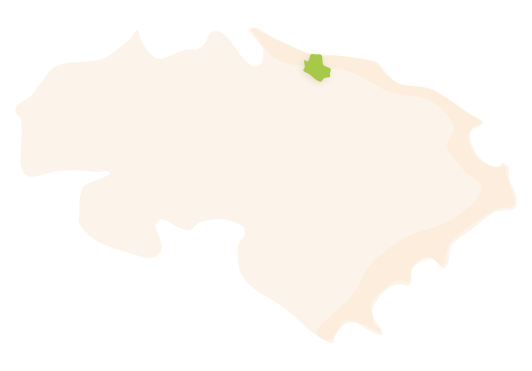Els Poblets is a municipality made up of three small villages or historical places called Setla, Mira-rosa and Miraflor. Located in the northernmost coastal area of La Marina Alta, at 14 metres above sea level, it has an area of 3.6 km² and a total of 2,721 inhabitants, known as Pobleters and Pobleteres.
 Els Poblets' municipal district. Surface area: 3.6 km². Population: 2,721 (INE data 2021).
Els Poblets' municipal district. Surface area: 3.6 km². Population: 2,721 (INE data 2021).HISTORY
It is the last municipality on the lower course of the Girona River, which is the main artery that crosses the whole area and shapes the landscape, from the wide riverbed within the urban area to its mouth at the iconic pebbled landscape of the beach known as L’Almadrava.
Regarding the most ancient settlements known in the area of Els Poblets, in L’Almadrava there is a site from the Roman period (1st-5th centuries AD). The coastal strip of this locality houses evidence of the earliest settlers: it is a reminder that this area lies along the route of the so-called Via Augusta, which used to connect the entire Mediterranean coast of Hispania. At the Roman site of L'Almadrava, it is possible to see the remains of several constructions belonging to a pottery, with storerooms for the clay, workshops and rooms for the workers. It was a production centre where mainly amphorae and tegulae (flat roof tiles for the construction of houses) were manufactured. This pottery centre shows the importance of the area in Roman times as mainly a place of wine production and transit, given its location in the heart of the Roman communication network between Saetabis (Xàtiva), Dianivm (Dénia) and Valentiae (Valencia).
As for the urban and rural landscape of this municipality, it is diluted within an Arab origin: from the presence of three small farms, called Els Llocs, which, over time, gave way to Setla, Mira-rosa and Miraflor, three villages that were united for good in 1971 and now popularly known by the name of Els Poblets.
With the conquest undertaken by Jaume I, these lands and the three Muslim farmsteads were incorporated into the Kingdom of Valencia and became a part of the Marquisate of Dénia. In the 14th century, a tower was built to watch over the communication routes. Towards the 16th century, they were no longer simple farmhouses and were known as Els Llocs; Miraflor (or Binaflor) belonged to the Perpinyà family and Setla and Mira-rosa (or Binarrosa) to the barony of the Huarte family. Later, the three were passed over to the Cardona family, who were lords of Ondara. Ecclesiastically, they depended on the Rectory of El Verger until 1953. In 1971, Setla and Mira-rosa merged, creating the current municipality which Miraflor soon joined.
A very prominent historical episode was King Felipe III and Margarita of Austria’s visit during their wedding celebrations, when they saw the “almadravas” (tuna fisheries) and experienced first-hand the transformation of the tuna caught there.
Salort, Femenia, Coll and Pons are some of the surnames that prove that this area was repopulated with people from the Balearic Islands after the expulsion of the Moriscos.
FESTIVITIES
- The celebration of Saint Antoni.
- The Night of Saint Joan with bonfires and open-air dancing (the date varies).
- The patron saint festivities in honour of El Diví Salvador, which take place from the 28th of July until the 6th of August, and include the Moros i Cristians festivities.
GASTRONOMY
- Regarding snack dishes, there are many in this area, but the “bull” with onion is a special one: a dish with salted tuna intestines that is slowly stewed. This recipe is deeply rooted in the local history of fishing for tuna, which used to fill up the “almadravas” (tuna fisheries) of the coast.
- Rice is also a fundamental part of the diet in this region. The recipe with peeled broad beans stands out, being a type of rice dish made with dried and peeled broad beans that are soaked the day before and which give a great consistency to the soupy rice that is made with it.
- Prawn with chard is one of the most typical dishes of the region, especially linked to the municipalities of the lower part of the River Girona. Even though its name says it is made with prawn, it is, in fact, a variety of freshwater shrimp or river shrimp.
- Other seafood dishes worth trying are octopus stew, sea urchins, fish stew or pickled sardines.